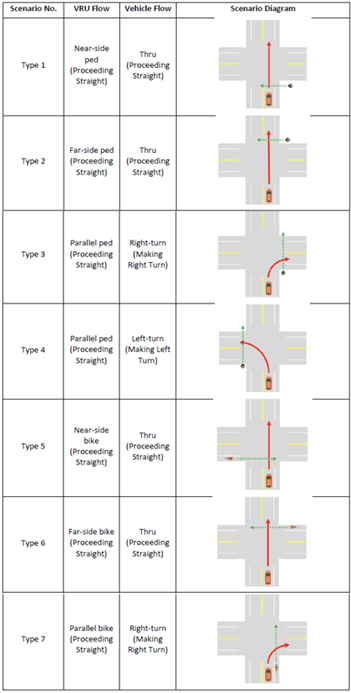A Simulation Study Estimates That Communications between Vehicles and Vulnerable Road Users Could Potentially Reduce 97 Percent of Crashes Where Vehicles Are Turning into the Path of a Pedestrian or Bicyclist.
Researchers in California Used Microscopic Simulation to Assess Multiple Vulnerable Road User Application Concepts in Signalized Intersection Collision Scenarios.
Statewide, California, United States
Analysis of Intelligent Vehicle Technologies to Improve Vulnerable Road Users Safety at Signalized Intersections
Summary Information
Nearly a quarter of all reported crash-related fatalities in California involved Vulnerable Road Users (VRU) such as pedestrians and bicyclists, often occurring at intersections. Researchers investigated how Intelligent Vehicle Technologies (IVT) could potentially improve VRU safety under different conditions (e.g., varied sight distance and traffic flow) at signalized intersections. Risk factors related to crash injury severity for VRU-related crashes at signalized intersections in California cities were identified using historical crash data. Using a traffic simulation model, the safety impact of four selected IVT applications and concepts on selected critical collision scenarios was evaluated under different market penetration scenarios. The IVT concepts included:
- Blind Spot Detection (BSD): a sensor-based system on board vehicles, which detects objects in the vehicle’s blind spot
- VRU Beacon Systems (VBS): a one-way wireless-communication-based concept where a VRU carries a device that transmits its location and heading to all vehicles in the intersection area
- Bicycle/Pedestrian to Vehicle Communication (BPTV): a two-way wireless-communication-based concept where both VRUs and surrounding vehicles communicate with each other
- Intersection Safety (INS): a centralized vehicle-to-infrastructure (V2I) concept where infrastructure-based sensors collect real-time data on all the vehicles and VRUs around the intersection, and provide safety guidance through wireless communication
Methodology
Crash data from 20 cities with high crash rankings (provided by the California Office of Traffic Safety) were compiled using a five-year (2014-2018) statewide dataset from the California Statewide Integrated Traffic Records System. This dataset was used to study the risk factors on crash injury severity for VRU-related crashes at signalized intersections in cities in California. Multinomial logit statistical models were used to identify typical collision types for crashes involving pedestrians and bicyclists. Researchers defined seven critical VRU-related intersection collision scenarios, shown in Figure 1, for study using a microscopic traffic simulation package, SUMO. Parameters in the simulation were modified to simulate the sensing and communication features of the four IVT concepts in order to assess the effectiveness of each IVT concept in reducing VRU-related crashes at intersections. The researchers defined a crash as occurring in the simulation if the time-to-collision was less than 1.5 seconds, and tabulated average crash counts over 5 iterations of 12-hour simulation runs.

Findings
- INS was found to be the most efficient at reducing crashes in the simulations for turning movement scenarios (Types 3, 4, and 7). BSD had the smallest effect in crash reduction in these scenarios.
- Simulation results indicated that BPTV and INS technologies had the potential to prevent nearly all collisions under certain conditions and scenarios. For example, with a 100 percent penetration rate, collision counts dropped by 97 percent with BPTV and 99 percent with INS when passenger cars were turning left into a pedestrian’s path (type 4). On average, crash reductions for the type 4 scenario were 44 percent for BSD and 84 percent for VBS.
- Under a 100 percent penetration assumption, for the scenario where passenger cars turned right into the pedestrian’s path (type 3), BPTV and INS had a 99 percent lower crash count compared to the no technology case. VBS reduced crashes by 66 percent while BSD did not reduce crashes for passenger cars. When the vehicle was a truck, a 64 percent crash reduction was found for BSD.
- For the scenario where the pedestrian crosses the intersection on the near side (type 1), the simulation results do not show any reduction in crashes with the modeled IVT concepts. Where the VRU is a bicyclist instead (type 5), an average reduction in crashes of 14 percent was found for BSD, 45 percent for VBS, 61 percent for BPTV, and 56 percent for INS.
- When examining cases at lower (25 percent) market penetration rates, INS had the best collision reduction effect among the simulated IVT technologies, with at least a 35 percent crash reduction in type 2-7 scenarios.
